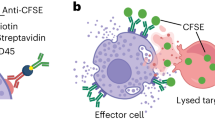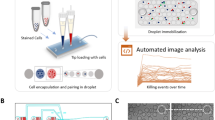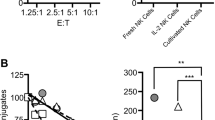Abstract
In vitro techniques for the evaluation of the cytotoxicity of immune cells are important both for the routine assessment of the cytolytic activity in samples for clinical or experimental use and for basic studies of the interaction between killer and target cells. Especially in the latter case, it is important not only to quantify target cell death as an endpoint, but also to observe the interaction and to recover effectors and targets for further analysis. We present a new method that offers considerable improvements for both types of applications, in comparison with the standard radioactivity release assays used today. The morphometric cytotoxicity assay (Mo.C.A.) estimates the extent of target cell lysis by measuring the openings that appear in a confluent monolayer of adherent cells as killed cells detach from the plastic on which they were spread. Two hours after the inoculation of the effector cells, nonadherent killer and dead target cells are washed off and the remaining monolayer is fixed and stained with Coomassie blue. Elementary computer-assisted image analysis allows then to calculate the percentage of open space, which is a parameter for the extent of lysis. As the Mo.C.A. is easy, and does not rely on the use of radioactive compounds or sophisticated equipment, we provide evidence that it should be valuable for the routine analysis of cytotoxicity in various cell samples. In addition, the method offers great flexibility in the choice of target cells and allows for continuous microscopic observation of the live cultures. The interaction can also be stopped at any time, and the effector and (unlabeled) target cells can be recovered separately. Therefore, the method should also offer new possibilities for the basic study of killer cell biology.
Similar content being viewed by others
Introduction
As targets, we used monolayers of the immortalized murine fibroblast-like 10T1/2 cell line (Table 1) because it forms homogenous, confluent monolayers of extensively spread cells. As effectors, we used murine and human lymphokine activated killer (LAK) cells. Nylon wool nonadherent mouse spleen cells were treated with IL-2 or IL-15 for 5 days, or with IL-2 and IL-12 for 5 and 3 days, respectively (Geldhof et al, 1998). Human mononuclear cells were prepared by density-gradient centrifugation of peripheral blood from healthy donors. The cells were cultured for 3 days with recombinant IL-2 (Whiteside, 1996). Inoculated on 10T1/2 monolayers in 10 cm2 tissue culture dishes (Falcon, Sunnyvale, California) was 1 ml of LAK cell suspensions at different effector over target (E/T) ratios. Within 15 minutes after the inoculation of LAK cells on the monolayers, individual 10T1/2 cells contracted rapidly, leaving openings in the monolayer. We observed blebbing on the surface of the contracted cells and, eventually, fragmentation. The destruction of a 10T1/2 cell was completed in about 10 minutes. After 1 hour, no more 10T1/2 cells were seen to contract. The interaction could be videotaped using a microscope in a cabinet at 37° C. An animation showing these events is available at www.uscapjournals.org.
Routinely, the assay was stopped after 2 hours of interaction by twice adding 1 ml of Coomassie blue solution (0.2% R250 Coomassie Brilliant blue [Sigma, St. Louis, Missouri] in acetic acid/methanol/water [10/45/45: v/v/v]). After 15 minutes the dishes were abundantly rinsed with water and air-dried for storage and later analysis. Most of the dead 10T1/2 cells and their debris, as well as unattached LAK cells, disappeared during the rinses (Fig. 1, a to c). Low power microscopic video images of the stained monolayers can be imported into any commercial or public domain computer program for image analysis. We used a × 6.3 objective, and the NIH image software (National Institutes of Health, available at: http://rsb.info.nih.gov/nih-image/). After digital contrast enhancement, the gray level images were converted into a binary image, subcellular details scrapped, and the ratio between the resulting white (cleared) and black (confluent) areas (Fig. 1, d to f) used as a parameter of monolayer lysis: “% clearance” is the cleared cell-free area as a percentage of the total area of the microscope field (averaged for 10 fields per condition).
Detection of lymphokine activated killer cell lysis in cultured target cell monolayer using the morphometric cytotoxicity assay (Mo.C.A.). a to c, Coomassie blue stained monolayers of 10T1/2 cells at high magnification. a, Confluent monolayer before addition of lymphokine-activated killer (LAK) cells; b, Monolayer incubated with 106 LAK (L) cells for 2 hours; c, Monolayer incubated with 2.106LAK (L) cells for 2 hours. Bar = 25 μm. d to f, Image processing of Coomassie blue stained 10T1/2 monolayers after incubation with IL-2-activated killer cells. Arbitrary microscopic fields (objective magnification × 6.3) are imported to a personal computer. d, The picture is converted to obtain a binary image; e, Clear and confluent areas are homogenized by excluding objects smaller than a cell (f). Bar = 140 μm.
With syngeneic (C3H) IL-2 activated LAK cells, lysis of 10T1/2 cells was noticeable from an E/T ratio of 0.75/1 and reached a maximum of approximately 50% at a ratio of 6/1 (Fig. 2). The same effectors and targets were tested in parallel by the classical 111In-release method (Geldhof et al, 1995). The Mo.C.A. is clearly more sensitive, as we needed a fivefold higher E/T ratio to obtain comparable levels of lysis by the 111In-release method (30% specific release with an E/T ratio of 20/1). Murine LAK cells from different haplotypes had similar lytic activity in the Mo.C.A. Human LAK cells caused a slightly lower clearance (Fig. 2). We also evaluated the activation status of killer cells activated by different lymphokine treatments. LAKs activated with IL-2 plus IL-12 were significantly more cytolytic to 10T1/2 than IL-2- or IL-15-activated LAKs. This distinction was also seen, but less pronounced, in the 111In-release assay.
Analysis of the sensitivity of 10T1/2 to different LAK populations by the Mo.C.A. The graph shows the effect of syngeneic (C3H mice, H-2k haplotype [Harlan CPB]), allogeneic (AKR, C57BL/6, and BALB/c mice; H-2k, H-2b, and H-2d haplotype, respectively [Harlan CPB]), and xenogeneic (human) effector cells. Confluent 10T1/2 monolayers were incubated with LAK cells at different E/T ratio’s for 2 hours. The remaining adherent target cells were fixed and stained with Coomassie blue. Percent clearance was measured in 20 different arbitrary microscopic fields (10 fields in duplicate dishes). Mean values and sem of 3 to 8 experiments, with linear regression plots.
As alternative target cell lines, we used epithelial, endothelial, and fibroblast-like cell lines from different species (Table 1). We found that many types of cell lines can be used in the Mo.C.A. provided they form uniform monolayers in culture, but their sensitivity to LAK cell-mediated lysis varied widely: from 60% (BAEC) to 0% (MDCK). In mixed target cell monolayers (prepared as in Verschueren et al, 1991), LAK cells killed 10T1/2 cells very efficiently, whereas MDCK cells were left intact, showing that soluble activating factors produced by the sensitive 10T1/2 or inactivating factors produced by the resistant MDCK cells were not responsible for the difference in sensitivity. Other interesting targets included ICAM-1 deficient endothelial cell monolayers (more sensitive than the wild type) and B7-1 transfected 3T3 cells (more sensitive than the wild type).
An additional opportunity with the Mo.C.A. is that the LAK cells could be recovered from the interacting cultures by simple washings. Thus, we could show by Annexin V-FITC and propidium iodide staining, followed by fluorescent activated cell sorter analysis (Vermes et al, 1995), that the level of apoptosis in LAK cells was increased from 12% to 32% after interaction with 3T3 targets.
In conclusion, the Mo.C.A. provides for a very simple, sensitive, and versatile method for the assessment of cytolytic activity of killer cells. It may facilitate routine analysis (eg, in clinical settings), but it may also offer new opportunities for the fundamental analysis of the interaction between cytotoxic cells and their targets.
References
Geldhof AB, Moser M, Lespagnard L, Thielemans K, and De Baetselier P (1998). Interleukin-12-activated natural killer cells recognize B7 costimulatory molecules on tumor cells and autologous dendritic cells. Blood 91: 196–206.
Geldhof AB, Raes G, Bakkus M, Devos S, Thielemans K, and De Baetselier P (1995). Expression of B7-1 by highly metastatic mouse T lymphomas induces optimal natural killer cell-mediated cytotoxicity. Cancer Res 55: 2730–2733.
Reiss Y, Hoch G, Deutsch U, and Engelhardt B (1998). T cell interaction with ICAM-1-deficient endothelium in vitro: Essential role for ICAM-1 and ICAM-2 in transendothelial migration of T cells. Eur J Immunol 28: 3086–3099.
Reznikoff CA, Brankow DW, and Heidelberger C (1973). Establishment and characterization of a cloned line of C3H mouse embryo cells sensitive to postconfluence inhibition of division. Cancer Res 33: 3231–3238.
Vermes I, Haanen C, Steffens-Nakken H, and Reutelingsperger C (1995). A novel assay for apoptosis. Flow cytometric detection of phosphatidylserine expression on early apoptotic cells using fluorescein labeled Annexin V. J Immunol Methods 184: 39–51.
Verschueren H, De Bruyne GK, Dewit J, De Baetselier P, and Mareel MM (1991). Metastatic T-cell hybridoma cells display target preference for invasion (‘homing’) in tissue culture models. Anticancer Res 11: 1029–1038.
Whiteside TL (1996). Isolation of human NK cells and generation of LAK activity. In: Coligan JE, Kruisbeek AM, Margulies DH, Shevach EM, and Strober W, editors. Current protocols in immunology. New York: J. Wiley & Sons, Inc., 7.7.1–7.7.11.
Acknowledgements
We thank J. Dewit, J. De Braekeleer, L. Brijs, M. Gobert, E. Vercauteren, and E. Omasta for technical assistance and Hoffman-LaRoche, Inc. and Genetics Institute, Inc. for the recombinant IL-12.
Author information
Authors and Affiliations
Corresponding author
Additional information
This work is supported by the Fund for Scientific Research - Flanders (Belgium): Fellowship of A.B.G. and grant no. 1.5.213.00.
Rights and permissions
About this article
Cite this article
Geldhof, A., De Meyer, K., De Baetselier, P. et al. Morphometric Analysis of Cytolysis in Cultured Cell Monolayers: A Simple and Versatile Method for the Evaluation of the Cytotoxic Activity and the Fate of LAK Cells. Lab Invest 82, 105–107 (2002). https://doi.org/10.1038/labinvest.3780400
Received:
Published:
Issue Date:
DOI: https://doi.org/10.1038/labinvest.3780400





